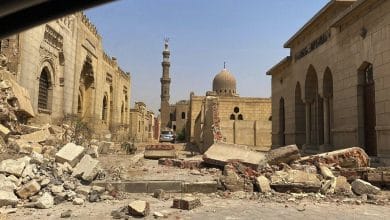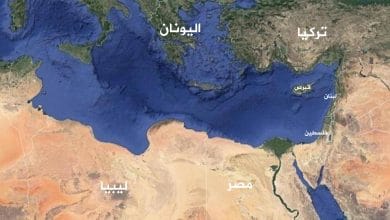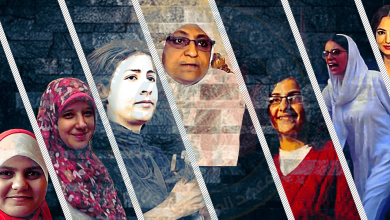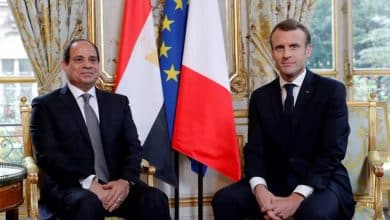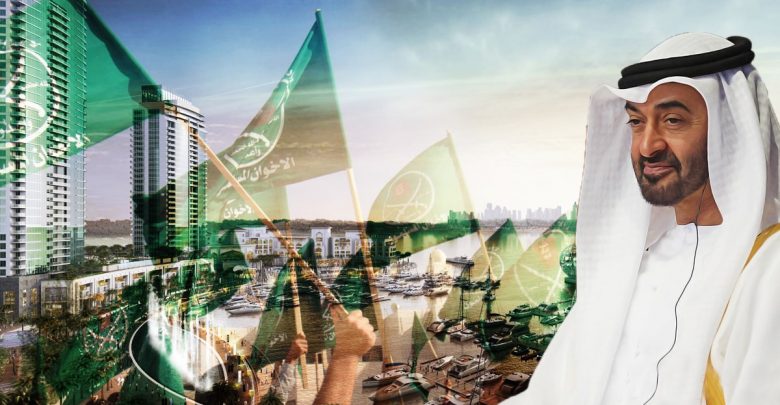
Introduction
In November 2014, the United Arab Emirates (UAE) declared the Muslim Brotherhood (MB) – including its local affiliate- as a terrorist group (El-Gamal, 2014). The relationship between the UAE and MB (or its Emirati branch: al-Islah) dates back to the 1970s, developing from almost friendly to increasingly tensional and aggressive, especially with the occurrence of the Arab Uprisings in 2010-2011. Designating the MB as a terrorist organization was only a legal- move in a series of moves and strategies of “total war” fought in almost all spheres (political, ideological, economic and etc.) to eliminate the MB’s (or Islamism’s) influence, if not existence, not only locally or regionally, but even internationally.
The UAE’s economic power seems to be the essence of its power in general. That is seen in the fact that it occupies top positions in some global economic rankings more than other power types (i.e. military and soft powers). According to the World Bank, the UAE, despite its smallness, has the fourth biggest GDP in the Middle East and North Africa (MENA), in 2017, with around $382.575 billion (compared to $851549, $686738, $454.013 of Turkey, Saudi Arabia, and Iran, respectively) (“data,” n. d). Moreover, in a report of the Organization for Economic Co-operation and Development (OECD), the UAE was declared to be the world’s top aid donor compared to its wealth in 2016 as it was in the preceding two years (“UAE ranked,” 2017). While we do not see the UAE in the 2017 military ranking (Woody, 2018) or 2018 soft power ranking (Mcclory, 2018). Due to this, we will proceed with the economic aspect of the above-mentioned war by the UAE on the MB.
The question of our paper is: how has the UAE used its economic power to counter the MB after the Arab Uprisings in 2011? The aim of this paper is to discern the economic means used by the UAE in its war against the MB. That suggests that our paper is descriptive answering the question “how,” rather than explanatory answering the question “why”. Furthermore, our study would focus on its subject in the aftermath of the Arab Uprisings. The paper will start by reviewing the literature available on the UAE-MB relations, as well as on the UAE’s political economy relevant to our question. After that, background information on the UAE-MB relations will be presented, before we start answering our research question. In response to our question, we will categorize our finding intro three categories of political economic policies: within the state (domestic), with other states (inter-state or international), and with non-state actors.
In the first category within our answer (i.e. domestic political economic policy), we will briefly see how the internal infrastructure investments done by the state aimed to pacify the potential sympathizers with the MB’s calls for reformations with the outbreak of the Arab Uprisings. While discussing the UAE’s international political economy, on the other hand, we will discern how the UAE uses its foreign aids, foreign direct investment (FDI), trade bans, and other financial tools to support countries with similar anti-MB sentiments, and threaten those countries that diverge from that direction. Coming, finally, to the non-state actors sponsored by the UAE, we will show how the UAE ruthlessly counters the MB through the use or sponsorship of a wide range of non-state actors (religious discourses and institutions, research centers and think tanks, rebel and militant groups, banks and campaign companies).
Literature Review
The literature relevant to our research falls in topics like: the Gulf-MB relations, the Gulf and the “Arab Spring,” the Gulf’s foreign aid policy, the inter-Gulf relations and so on. Looking at the literature from the UAE-MB relations perspective, we will categorize it into the following categories: opinionated, theoretical, historical, geopolitical, military, religious/intellectual, and most importantly for us: economic (or political economic). We will proceed with brief examination of them, focusing on their contribution on the UAE-MB issue, and then we will show the contribution of our paper to the literature.
By “opinionated literature” I mean those researches (mostly think-tank’s) done to convince the decision makers, with an obvious agenda behind. Lekhraibani, Ruledge, and Forstenlechner (2015) and Forstenlechner, Rutledge, and Alnuaimi (2012) are two examples in which the authors have ties with the UAE, and try to defend and legitimize the UAE’s crackdown on the MB and convince the Western decision makers to view the importance of that crackdown for a capitalist “modern” future of the Arab world in the former paper, and to save the Arab world from the “pan-theocratic” danger of the MB in the latter. On the other hand, Ahmed (2015) who provide the MB with suggestion to counter the UAE’s pressure.
The theoretical literature are those papers which tackled the UAE-MB issue as a case study for further theoretical investigation. Roberts (2017) tried to understand the reason behind the divergent responses of the UAE and Qatar to the Arab Spring (or to the MB, in particular) despite all the similarities they have. He argues that it is due to some structural reasons we have such divergence:
(1) the unitary structure of Qatar versus the federal structure of the UAE (in which the leading emirate [Abu Dhabi] developed many concerns of the increasing influence of al-Islah under the patronage of the poorer emirates’ sheikhs).
(2) considering the key impact of the personality of the ruler on state policy the their tools is evident in both due to the structure of their political system, we have Qatar’s Hamad bin Khalifa Al-Thani assessing the MB as an asset in his policy to increase Qatar’s engagement of the influential actors in the region, while having Abu Dhabi’s Muhammad bin Zayed with his military background securitizing the MB issue. Moreover, as theorization of the political opposition possibility in the Gulf focused mostly on the ability of the state to counter it by economic patronage, Al-Zou’by and Başkan (2015), on the other hand, focused on the religious-based oppositional discourses in rentier monarchies, taking UAE-Islah as their case study.
The historical/legal literature focuses on the historical development of the UAE-MB (or Gulf-MB) relations (see Al-Nugaidan, 2013; Diwan, 2017; Freer, 2017; Hedges and Cafiero, 2017; Steinberg, 2017).
Such relations are mostly discussed from a legal political perspective in the sense that how the UAE accepts, bans, punishes the MB, for the legal political decision are the solid events to be recorded as history.
As to the geopolitical literature, we find them approaching the UAE within the context of other countries: like the Gulf Cooperation Council (GCC) context (see Berger, 2014), the context of Qatar and its crisis (see “the Qatar Crisis,” 2017) and the Egyptian context (see Fouad, 2016).
The military literature tackles the militarization of the UAE’s foreign policy “beyond money and diplomacy” (see Ragab, 2017). The religious/intellectual literature deals with the UAE’s sponsorship of some religious and intellectual groups to counter the MB’s influence (see Amasha, 2018; Gause III, 2017; Antar, 2016).
Coming to the economic literature, Al-Mezaini (2017), while analyzing the UAE’s foreign aid policy, shows how it (the UAE’s foreign aid policy) has transformed, with the breakout of the Arab Revolution, from and identity-based policy (Islam and Arabism), to be increasingly politicized and securitized, with a clear reference to the perceived threat posed by the MB in that period. Young (2017a) in her study of the “new politics of GCC economic statecraft,” took the “UAE’s aid and financial intervention in Egypt” as a case study, showing that the UAE’s aid (defined to include “non-restricted cash grants, injections to central banks…, in-kind oil and gas delivery,” “and facilitation of [state and private] foreign investment”) to Egypt has to do with the UAE’s will to weaken the MB and jihadist groups.
She (Young, 2017b) also demonstrate how the Egyptian economic dependency led it to join the UAE-Saudi-led blockade against Qatar. Finally, in their work the engagement of Arab Gulf states in Egypt and Tunisia since 2011: Rationale and impact, Sons and Wiese (2015) pointed out that the MB was one threat posed on the UAE with the Arab Uprisings, which made undermining their (the MB’s) influence on of their major interest in their political and economic engagement with Egypt and Tunisia since 2011.
Taking all that literature into consideration, we will find that none of the studies done (even in the economic literature) directed its attention to shed light on the economic aspect of the UAE’s war on the MB. Rather, the economic literature mentioned the UAE’s animosity with the MB as a defining interest for its political economic policies, which were discussed mostly in the context of its relations with other states or of the analysis of its foreign aid in general. This paper aims to contribute to the literature by illuminating the economic means the UAE has been using to fight the MB in different parts of the world.
The UAE and the MB: A Historical Overview
The relationship between the UAE and the MB can be said to pass from three millstones: friendly relations (early 1970s-1987), tensional relations (1988-2010), and aggressive relations (since 2011). In the friendly period, al-Islah gained the patronage of some Sheikhs (or rulers) (especially of the northern emirates), occupied important offices in the state (like the ministry of Justice, Religious Affairs and Endowment; the ministry of Education; and the ministry of Housing), created social capital of supporters and activities (Al-Nugaidan, 2013).
The tensional period was characterized with the UAE’s crackdown on the MB within its borders, which started with the UAE’s recognition of the increasing power of al-Islah, but al-Islah continued to exist in the society (especially in Ra’s Al-Khaima where they were protected by its Sheikh) in a way or another despite the suppression. That began with the state’s decision to stop the issue of al-Islah’s magazine in 1988; and followed in 1994 with the dissolution of al-Islah’s board of director, restriction of its activities, freeze of its external activities, and replacement under the supervision of the Ministry of Social Affairs, based on allegation by the Egyptian authorities that it supports terrorist groups in Egypt (Freer, 2015). In 2001 and with the 9/11 attacks, the UAE arrested more than 250 for crimes related to terrorism, many of them with MB sympathies; and in 2003, Muhammed bin Zayed, the Crown Prince of Abu Dhabi, had the last negotiation with al-Islah to severe their relations with the international MB, and to confine their works to dawah (Islamic proselytization), and with the refusal of al-Islah, the UAE tried to remove them from the ministries in which they held considerable influence (Hedges and Cafiero, 2017).
The Arab Uprisings was behind the start of the aggressive period in which the UAE set the elimination of the MB worldwide as a national interest. As the Arab Uprisings showed its ability to shake long-lasting and deep-rooted political regimes (like Bin Ali’s and Mubarak’s), and with the attempt of al-Islah (along with other liberal intellectual) to pressure the government to introduce reformations and enlarge the pool of the citizens entitled to vote (through a petition signed by 110 intellectuals and sent to the UAE rulers), the UAE government started to take aggressive measures against the MB members by revoking the nationality of some of them, arresting many others in 2012 (with allegations of terrorism and threatening of the state’s security), sentencing many of them to imprisonment in 2013, confiscating money, companies, and lands belonging to some of them, and declaring the MB as a terrorist organization in 2014 (Ahmed, 2015). Beside the crackdown domestically, the UAE has been ruthlessly trying, on the regional and international level, to end the MB in a way or another. And we will focus on all these trials from an economic perspective in the upcoming section.
The “Anti-MB” in the UAE’s Economic Policy
In this section we try to discern the political behind the economic, the interest behind the policy, or in particular, the “anti-MB” (or the interest of eliminating the MB) in the UAE’S economic policy. We do this on three levels: within the state (the domestic economic policy), with other states (the international economic policy), and with non-state actors.
Within the State: The Domestic Economic Policy
It has been observed, with the outbreak of the Arab Uprisings, that the Gulf countries as rentier states, used economic tools (or “bribes”) to prevent any revolutionary sympathies or movements in their countries. In the UAE, as in the other countries, the MB constituted a major constituent of such revolutionary sympathies. Al-Islah, as mentioned before, concentrated in the northern emirates, the poor emirates. It’s interesting to know that there has been a stark difference among the UAE’s emirates’ economic- and political- power, advantaging Abu Dhabi and Dubai, and disadvantaging the rest northern five emirates whose share in the UAE’s GDP in 2004-2014, put together, was only 15.5% compared to 55.9% and 28.6% of Abu Dhabi and Dubai respectively (Roberts, 2017). And as those northern Emirates suffer from health, education, unemployment, water, and electricity problems (“Al-Emarat Al-Shamaliyyah,” 2017), in addition to be the major concentration areas of the MB, the UAE tried to extinguish the flame of the revolution by promised investment in the infrastructure of those northern Emirates. That was done in March 2011 by a pledge to invest $1.5 billion by the UAE government to the northern emirates to enhance their infrastructure, after al-Islah has sent the petition to the government.
With other States: The International Economic Policy
In the international political economy, we examine the UAE’s behaviors against the MB by examining its foreign aid, foreign direct investment (FDI), trade, funds for regional organizations, and economic sanctions.
For the UAE’s foreign aid policy, the Arab Spring, especially MB threat, was decisive to change its direction from identity-inspired and diverse recipients-oriented foreign aid to politicalized and securitized foreign aid, as mentioned before (Al-Mezaini, 2017). The Egyptian case was the most striking. The UAE offered $3 billion to Egypt in 2011 after the Arab Spring when Egypt was in a transitional period under the rule of Supreme Council of the Armed Forces- a part of the old regime. But this aid was not delivered to Egypt as the MB were achieving successes in elections (El Gamal& Maclean, 2013). This money, and much more, found its way to Egypt in 2013 after the military coup against MB’s elected president Morsi took place.
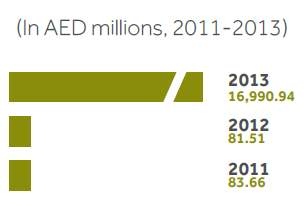
Table 1 UAE assistance to Egypt, source: UAE foreign aid report, 2014
Especially due to its exceptional support for the anti-MB military coup regime in Egypt in 2013, the UAE’s aid program increased by 375.5% according to an OECD’s report (Al-Mezaini, 2017). In the UAE’s published foreign aid reports, Egypt has been the largest recipient of the UAE’s foreign aid with US $4.63 billion and the US $3.21 billion in 2013 and 2014 respectively. Egypt seemed pivotal to the existential struggle with the MB that it deserved acquiring 52% of the UAE’s total foreign aid in 2014 (UAE Ministry of International Cooperation and Development (MICAD), 2015) and 98.6% of the UAE’s disbursed fund in 2013 (MICAD, 2014). The fact that these foreign aids are anti-MB bribes can be proven, not just by the explicit anti-MB rhetoric of both states, but also by comparing the UAE’s assistance to Egypt, as shown in Table 1, between 2011, 2012, and 2013. 2011 was the time of the Arab Spring, and from 2011 to 2012 UAE’s assistance decreases as the power shifted from the military to the MB, but in 2013 it increased dramatically as the anti-MB military came to rule again. Jordan, an important recipient of UAE’s foreign aid, showed also anti-MB behaviors, seen in the imprisonment of some of the MB members (Al-Naggar, 2014) including one of its leaders as he criticized UAE’s listing MB as a terrorist organization (“Ikhwan Al-Urdun,” 2014). And the news about the Mauritania’s moves toward the banning of the MB (Toumi and Cheif, 2018) can be understood in the context of the UAE’s million USD aid to the development of a Mauritanian village (Hassene, 2018).
Regarding FDI, the information about the UAE’s FDI outflow is very limited, which makes us unable to see the trajectories over time- which might have a political dimension. FDI can be used by the political authorities to support other countries through either through state investment of through encouraging private investments. Accordingly, I would expect an increase in the Emirati FDI outflow to states supporting anti-MB policies as a way of supporting their economies and a decrease of it to those who support them as a way to undermine their economic powers. Based on the available data, it is evident that of all states that have FDI outflows to Egypt, the UAE ranks the first, as to the Egyptian State Information Service website (2017) indicates, while other reports indicate that it’s the first among Arab states not internationally (“Al-Emarat Alo’ula,” 2017). The UAE’s FDI outflow to Turkey has a downward direction in 2013-2016 from $176 million to $ 37 million (“UAE: Value of FDI,” 2017), which can be due to Turkey’s government’s Islamist roots and its open doors toward MB members, even though that overall trajectory requires a deeper examination. The UAE’s FDI outflows to Qatar should have had negatively affected too with the blockade imposed on Qatar in 2017 by the UAE, Saudi Arabia, Egypt, and Bahrain.
Qatar crisis was also a very vivid example of how the UAE’s perception of the MB as a threat led to dramatic economic behaviors in order to limit the MB-supporting powers despite the evident degree of economic cost for the UAE itself. Qatar has followed a policy that favored the MB, and that is observed in hosting many of its members and leaders and allowing Al-Jazeera Channel to host them. Because of that and to change such MB-sympathetic policies, Qatar was diplomatically pressured many times by the UAE-Saudi alliance, exemplified by recalling their (i.e. UAE, Saudi Arabia, Bahrain) ambassadors from Qatar in 2014. When it seemed not efficient, that alliance (the UAE, Saudi Arabia, Egypt, and Bahrain) not just severed their diplomatic ties with Qatar, but also imposed a travel and trade ban. Qatar, being part of Gulf Cooperation Council (GCC) common market, is highly economically integrated with those states. This integration “has evolved well beyond a focus on free trade in goods to embrace high levels of cross-national labor and capital mobility, and the progressive opening of many sectors within each economy to all member states” (the World Bank, 2010). Even though this economic integration was achieved for real cooperation, Qatar’s integration with those Gulf countries was manipulated to constitute an economic blackmail to make it comply with their anti-MB political views. The lack of data makes us unable to analyze the exact economic cost of such embargo, but it is easy to realize the great damage (e.g. Qatar airways declared a net loss of more than $69 million because of that blockade [“Qatar airways,” 2018]).
The Blackmailing method was even used with countries beyond the Middle East and North Africa (MENA) region, as the UAE’s trade was also utilized to fight MB in countries like the United Kingdom (UK). The UAE, as the Guardian reported,“threatened to block billion-pound arms deals with the UK, stop inward investment and cut intelligence cooperation” if the UK does not act against MB (Ramesh, 2015). Moreover and beyond individual states, the UAE uses its economic capabilities to ensure the compliance of the region to its anti-MB policies as well. That is the case with the Arab League. The Arab League’s budget’s largest share is being paid by the UAE and the Saudis (Ragab, 2017). Therefore, there would be no surprise to know that the Arab League General Secretary welcomed the UAE’s listing MB- and many other political and non-political groups- in their list of terror (“Tarhib Arabi,” 2014).
With Non-State Actors
In this section we will see how the anti-MB as a national interest of the UAE has led it to sponsor non-state actors to counter the MB’s influence. We will see that with the UAE’s sponsorship of (or agreement with) militant and rebel groups, banks and propaganda companies, and religious and intellectual groups whose discourses were perfectly an anti-MB discourse.
After the election of the MB candidate, Morsi, to be the president of Egypt, the UAE was alarmed of the potential high threat posed on her by the MB and their increasing confidence and control. An oppositional group of some young people called Tamarroud (in English: rebel) emerged to make Morsi leave the presidency early by creating a public-opinion pressure through collecting signatures on petitions and protesting against him. In 2015, 2 years after the military coup against Morsi, a leak showed the UAE funded Tamarroud and the Egyptian- mostly Military- Intelligence (“UAE Funded Egyptian,” 2015). Egypt is not the only case where the UAE intervene to overthrow the pro-MB governments, Turkey was another case. Middle East Eye reported, based on sources close to the Turkish intelligence services, that the UAE supported the failed military coup attempt by transferring money to its plotters weeks before their move (Hearst, 2016). Moreover, the UAE has been funding Haftar, a marshal in Gaddafi’s army, in Libya with $50 billion to limit the influence of the Islamists (Al-Sharif, 2018). The UAE, indeed, funds the campaign of a Haftar-advocate candidate against the MB in the upcoming election (Ali, 2018) (as it tried before to tempt the Tunisian president to crackdown on the MB there by gifting him two cars [“Row in Tunisia,” 2015]).
Another leak from the email of Al-Otaiba, the UAE ambassador to the USA, by The Intercept, showed a plan by the UAE to wage a ‘financial war’ on Qatar. The plan is to manipulate the Qatari bonds and derivatives as a way to attack the Qatari currency. Banque Havilland, the bank that prepared the plan as the leaks show, planned to “drive down the value of Qatar’s bonds and increase the cost of insuring them, with the ultimate goal of creating a currency crisis that would drain the country’s cash reserves” (Grim & Walsh, 2017). In another move to pressure Qatar to give up its sympathetic policies toward the MB, the UAE had paid $333,000 for SCL Social Limited Company, according to Ainsley, Lehren, & Schecter (2018), in order to link Qatar with terrorism through social media campaigns. By this contract between the company and the National Media Council, the company is supposed to spread ads including anti-Qatar content and the hashtag #boycottqatar on Facebook, Twitter, and YouTube. And that was indeed implemented during the UN general assembly meeting in December 2017.
By its money, the UAE tries to influence the knowledge production and scholarly discourses about the region and Islam as well. For that purpose, the UAE tries to control the influential think tanks as was exemplified in the ‘secret gift’ of $200 million given by the UAE to one of the most influential American think tanks, the Middle East Institute (Grim, 2017). Furthermore, UAE tries to sponsor other Islamic discourses that would compete with the MB discourse, and present itself as a “moderate Islam” alternative. That is evident in two Emirati-supported intellectual Islamic trends: the Islamic Left, and Sufism. After the loss of its vitality in the Muslim societies, the Islamic Left was revived by the UAE and institutionalized in Mominoun (believers) Without Borders institute in 2013 in the UAE, having a huge research and documentary production for the sake of deconstructing Islamism (see Mouminoun Without Borders, n.d).
Coming to the Sufis sponsored by the UAE (or UAE Sufism), the UAE (and the coup government in Egypt) funds them to expand their influence, aiming to give them the leadership of official religions of Sunni Islam, especially by knowing their dominance in the leadership of al-Azhar in Egypt and the UAE’s sponsorship of it (al-Azhar) (Amasha, 2018). Tabah Institute, the Forum of Promoting Peace in the Muslim Societies, and the Muslim Elders Council are examples of UAE-based hubs of Sufi scholars promoting a pacifist version of Islam that always condemns extremism, in a clear reference to the MB.
Conclusion
This paper tried to illustrate the UAE’s use of economy to implement one of its political goals, that goal being the elimination of the MB as they were perceived by the UAE as a security threat. A brief history of the UAE-MB relations was presented and showed how it developed from a friendly relations (when the MB expanded its influence and gained the patronage of some Sheikhs), then a tensional relations (when the UAE suppressed the local MB and tried to limit its influence in the country), to end up with aggressive relations (in which the UAE set the elimination of the MB’s influence around the world).
To discern the economic tools used by the UAE in its fight against the MB, we tackled these tools within three categories: within the state (in which we showed how the UAE used money to pacify any revolutionary dissent from the poorer emirates), with other states (in which we showed how the UAE used its foreign aid, FDI, economic threats and punishments, and sponsoring of regional organizations to promote its anti-MB sentiment), and with non-state actors (in which we showed how the UAE has sponsored militant and rebel groups, think-tanks, research centers, and intellectual and religious groups, and how they had agreements with banks and propaganda companies to counter the MB’s influence).
Bibliography
“Al-Emarat al-oula arabiyyan fi al-Istithmar al-mobasher bimasr” (the UAE is the first in FDI outflow to Egypt). (2017, August 20). Al-Ain Al-Ekhbariyyah. Retrieved from al ain and al shark
“Ikhwan Al-Urdun.. Hal yatem tasnefaha kamunazzama irhabiyyah?” (Jordan’s Muslim Brotherhood.. Will It Be Classified As a Terrorist Organizatiob?). (2014). Retrieved from link
“Qatar Airways files $69 million loss amid Gulf crisis.” (2018). The Economic Times. Retrieved from link
“Row in Tunisia over claims that UAE is buying political influence.” (2015). Middle East Eye. Retrieved from link
“Tarhib Arabi bitasneef al-emarat li-monazzamat irhabiyyah” (Arab welcoming with UAE’s listing of terrorist organizations). (2014). Assabah Aljadeed. Retrieved from link
“The boycott of Qatar is hurting its enforcers.” (2017). The Economist. Retrieved from link
“UAE funded Egyptian anti-Morsi group, leaked conversation suggests”. (2015, March 02). The New Arab. Retrieved from link
“Value of foreign direct investments from the United Arab Emirates into Turkey from 2005 to 2016 ( in million U.S. dollars).” (2018). Statista. Retrieved link
Ahmed, E. (2016). Al-Ikhwan Al-Muslimun fee Dawlat Al-Emarat: Al-Tahaddiyat wal-Aafaq (The Muslim Brotherhood in the UAE: The Challenges and the Horizons). Egyptian Institute for Studies. Retrieved from
Ainsley, J., Lehren, A., & Schecter, A. R. (2018). The Mueller effect: FARA filings soar in shadow of Manafort, Flynn probes. NBC News. Retrieved from link
Ali, O. (2018) Amwal Emaratiyyah lil-Tarweej li-Murashshahi Haftar lil-Entikhabat Al-Libiyyah Al-Muqbilah. The New Arab. Retrieved from
Al-Mezaini, K. (2017). From Identities to Politics: UAE Foreign Aid. In Bergamaschi, I & Moore, P & Tickner, A (Eds.), South-South Cooperation Beyond the Myths:Rising Donors, New Aid Practices? (pp. 225-244). London, England: Springer Nature.
Al-Naggar, M. (2014). Al-Urdun Yuwaggeh Tuham Al-Irhab li-Mu’takaleen men Al-Ikhwan. Al-Jazeera. Retrieved from
Al-Nugaidan, M. (2013). Al-Ikhwan Al-Muslimun fee Al-Emarat Al-Tamaddud wal-Inhisar. Al-Mesbar Studies & Research Center. Retrieved from
Al-Sharif, A. (2018). Tafaseel Istila’ Al-Emarat A’la Amwal Libiyyah bi 50 Milyar Dolar. The New Arabi. Retrieved from
Al-Zo’by, M & Başkan, B. (2015). Discourse and oppositionality in the Arab Spring: The case of the Muslim Brotherhood in the UAE. International sociology. Retrieved from
Amasha, M. (2018). Al-Emarat wal Sufiyyah fi misr: harait al-fikr wal-haraka (The UAE and Sufism in Egypt: the maps of thought and action). EIPSS. Retrieved from https://eipss-eg.org/?p=33503
Antar, G. (2016). Mu’tamar Gruzni wa sahat Al-tanafus al-suudi Al-Emarati (Ghrozni Conference and the Saudi- Emirati competition spheres). Egyptian Institute for Studies. Retrieved from
Berger, L. (2014). The Gulf Cooperation Council between Unity and Discord towards the Arab Uprisings. Sicherheit Und Frieden (S F) / Security and Peace, 32(4), 260-264. Retrieved from
Diwan, K. (2017). The future of the Muslim Brotherhood in the Gulf. In The Qatar Crisis. Retrieved from
El Gamal, R., & Maclean, W. (2013). Analysis: Rise of Islamists frays strategic UAE-Egyptian relations. Reuters. Retrieved from
El-Gamal, R. (2014). UAE lists Muslim Brotherhood as terrorist group. Reuters. Retrieved from
Forstenlechner, I., Rutledge, E. & Alnuaimi, R. S. (2012). The UAE, the “Arab Spring” and Different Types of Dissent. Middle East Policy, 19: 54–67. doi:10.1111/j.1475-4967.2012.00559.x
Fouad, K. (2016). Ba’d 3 Sanawat: Hudud Al-Da’m Al-Emarati le-Nizam Al-Sisi. Egyptian Institute for Studies. Retrieved from
Freer, C. (2015). The Muslim Brotherhood in the Emirates: Anatomy of a crackdown. Middle East Eye. Retrieved from link.
Freer, C. (2017). From Co-operation to Crackdown. In The Qatar Crisis. Retrieved from
Gause III, F,G. (2017). What the Qatar crisis shows about the Middle East. In The Qatar Crisis. Retrieved from link
Grim, R. (2017). Gulf Government Gave Secret $20 Million Gift To D.C. Think Tank. The Intercept. Retrieved from
Grim, R., & Walsh, B. (2017). Leaked Documents Expose Stunning Plan to Wage Financial War on Qatar – and Steal the World Cup. The Intercept. Retrieved from
Hassene, A. (2018). Al-Emarat.. Milyona dolar lida’m Qaryat Al-Makfufeen fee muritanya (The UAE.. 2 million Dollars to support the “blinds’” village in Mauritania. Sahara Media. Retrieved from
Hedges, M. & Cafiero, G. (2017), The GCC and the Muslim Brotherhood: What Does the Future Hold? Middle East Policy, 24: 129–153. doi:10.1111/mepo.12256
Lekhraibani, R. Rutledge,E. & Forstenlechner, I. (2015). Securing a Dynamic and Open Economy: The UAE’s Quest for Stability. Middle East Policy. Retrieved from
Mcclory, J. (2018). The Soft Power 30. Retrieved from
Mouminoun Without Borders. (2018). Retrieved from
Project on Middle East Political Science (POMEPS). (2017). The Qatar Crisis. Retrieved from
Ragab, E. (2017). Beyond Money and Diplomacy: Regional Policies of Saudi Arabia and UAE after the Arab Spring. The International Spectator,52(2), 37-53. doi:10.1080/03932729.2017.1309101
Ramesh, R. (2015, November 06). UAE told UK: crack down on Muslim Brotherhood or lose arms deals. The Guardian. Retrieved from
Report, S. (2017, April 11). UAE ranked world’s top aid donor for third consecutive year. Gulf News. Retrieved from
Roberts, D. B. (2017). Qatar and the UAE: Exploring Divergent Responses to the Arab Spring. The Middle East Journal,71(4), 544-562. doi:10.3751/71.4.12
State Information Service. (n.d.). Al-elakat Al-Iktisadiyyah (the economic relations). Retrieved from
Steingberg, G. (2017). the Gulf States and the Muslim Brotherhood. In The Qatar Crisis. Retrieved from
The World Bank. (n.d.). “Data.” Retrieved from
The World Bank. (2010). Economic Integration in the GCC. Washington DC, USA: the World Bank.
Toumi,H & Chief, B. (2018). Mauritania moving toward banning Muslim Brotherhood? Gulf News. Retrieved from
UAE Ministry of International Cooperation and Development (MICAD). (2014). United Arab Emirates Foreign Aid 2013. Abu Dhabi, UAE: Ministry of International Cooperation and Development (MICAD).
UAE Ministry of International Cooperation and Development (MICAD). (2015). United Arab Emirates Foreign Aid 2014. Abu Dhabi, UAE: Ministry of International Cooperation and Development (MICAD).
Woody, C. (2018). These are the 25 most powerful militaries in the world- and there’s a clear winner. Business Insider. Retrieved from
Young, K. E. (2017a). A New Politics of GCC Economic Statecraft: The Case of UAE Aid and Financial Intervention in Egypt. Journal of Arabian Studies,7(1), 113-136. doi:10.1080/21534764.2017.1316051
Young. K. (2017b) How Egypt wound up in the center of a Gulf Cooperation Council dispute on Qatar. In The Qatar Crisis. Retrieved from
David Hearst, Exclusive: the emirati plan for ruling Egypt, Middle East Eye, .2015November 21, Arabic bost ([1])
[1] The views expressed in this article are entirely those of the author’s and do not necessarily reflect the views of EIPSS.
